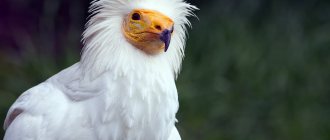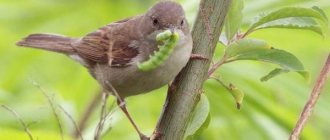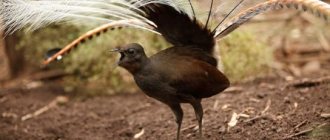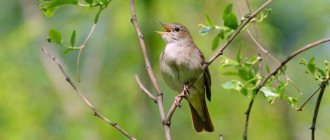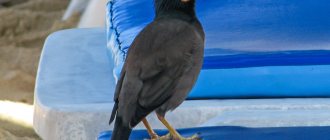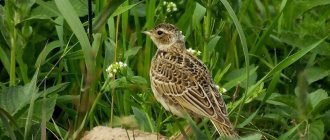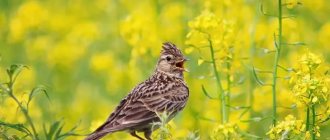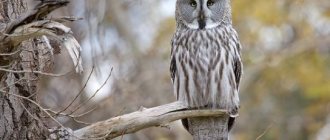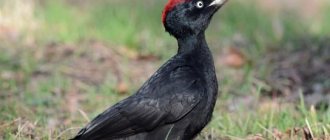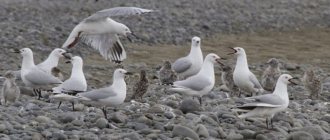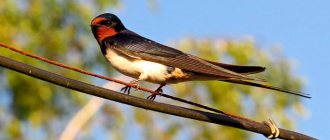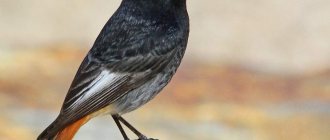The lark is a small motley bird of the order Passeriformes of the Lark family. It looks like a sparrow, but its head is decorated with an elegant crest. The lark has strong wings to fly to great heights. And a ringing voice to sing a spring song to the whole area. However, the lark spends most of its time on the ground, settles in open spaces, and makes its nest in fields, steppes and meadows. It also feeds on the ground, running through the fields in search of seeds and sprouts on its short legs, suitable for moving on the ground.
The lark lives and feeds on the ground, its legs are adapted for walking
WHAT DOES IT EAT?
A Crested Lark searches for food on the ground. It probes the soil to a depth of two centimeters and uses its strong, slightly curved beak to catch beetles, grasshoppers, caterpillars, spiders, ants and large earthworms. The Crested Lark's diet also includes various seeds, mainly grains, grasses and weeds, and green parts of plants. The ideal shape of the crested lark's beak is excellent for removing the hard chitinous shells of beetles and husking grains from spikelets.
The crested lark can even catch a dragonfly or fly in the air, however, to make it easier to digest such prey, it tears off its wings before swallowing. In winter, larks feed mainly on grass seeds.
Natural enemies
Larks are practically not protected from natural enemies, and there are plenty of them. Basically, they are hunted by various predatory animals, as well as birds of prey, including reptiles. In other words, there are quite a lot of people willing, and feathered predators are lured by his loud singing at altitude.
Important to remember! Larks bring enormous benefits to agriculture by destroying various pests. In addition, the songs of these birds relax a person and lift his spirits.
When the lark sings while at a considerable height, it is especially defenseless against swift aerial predators. Although rare, he is saved by the fact that he falls down like a stone, hiding in the thick grass. On the ground, the lark family also has a hard time, since its nests are destroyed by ground predators, of which there are also many.
LIFESTYLE
Crested larks live in pairs or small flocks of 3-5 individuals. It is not uncommon to see a flock of 15 birds searching for food together or flying south. Typically such flocks consist of younger birds. Adult larks stay mainly in small groups. Thanks to the rounded shape of their wings and short tail, crested larks appear to be quite large birds in flight. Birds run along the ground in small steps. They spend most of the day collecting insects, and in the evening they look for a hole in which they sleep.
Mating games
The voice also has another important purpose - with its help, males call females to mate. As soon as spring comes and it gets warm, the birds begin searching for their soulmate. Most often, old married couples reunite after finding each other. Crested larks remain faithful to their partner; the union can last more than one year. And young males begin to prove to females that they are better than their competitors.
The meaning of the ongoing battles is who will outsing whom. The males surround the female and dance around, spreading their wings, shaking their tails and stretching their necks. At the same time, they constantly sing, without stopping for a second. The winner is the one who lasted the longest, or the one whom the female preferred.
REPRODUCTION
Crested larks can remain in pairs for several years. Already at the end of winter, crested larks are found in pairs. In the spring, birds perform mating dances, during which they fly into the air singing and, after a short current flight, land near the place where the nest is built. Crested larks also display on the ground. Males jump around their partners, stretching their necks forward, fanning out their tails and swinging their outstretched wings, while they sing loudly. The female watches the male, sitting motionless on the ground, and in no way participates in the performance. The female alone builds a nest on the ground and lines it with grass, feathers or pieces of moss. In some areas, birds nest exclusively near human habitation, for which in Ukraine they are nicknamed “neighbors.” The female makes two clutches per season. The first clutch usually contains 5 eggs, and the second clutch contains 3 to 4 eggs. Only the female incubates the clutch. If the clutch is destroyed, then after some time the female will lay eggs again. Chicks hatched from eggs are blind and covered with yellowish, straw-colored down. The parents feed the chicks together. They bring them insects. The chick that opens its beak more often than others receives the most food. The chicks leave the nest after 9 days, but their parents continue to feed them. After 20 days, the chicks can already fly. In case of danger, the chicks hug the ground or hide in the grass.
Legends and traditions
There is a beautiful legend about how God threw a piece of earth into the sky, and this loud, earth-colored bird appeared. For a long time, many European peoples associated the lark with spring and harvest. Killing a lark was considered a great sin.
In the ancient Slavic tradition there was a belief that the lark, with its song, connects heaven and earth with invisible strings and asks higher powers for rain. Many peoples believed that the lark in the sky sings hymns to God, offering him praise and prayers. The lark loves to bathe in the dust, clean its feathers, and people say: a lark in the dust means rain.
Traditionally, on the Day of the Forty Martyrs, larks are baked from dough.
The folk holiday of the spring equinox - “Magpies” (with the emphasis on the first syllable), which falls in the last week of March, just in time for the arrival of the larks, is associated with the magical abilities of larks to ask higher powers for rain, fertility and the future harvest. In houses they made larks from dough and held rituals to call for spring: they sang “chants”, left baked larks on the windows, planted them on branches, and treated neighbors. In the Orthodox tradition, larks are considered a symbol of the souls of Christians who suffered for their faith, and are baked for the commemoration of the Forty Martyrs on March 22.
WHERE DOES IT LIVE?
Crested larks typically seek out open spaces with low, sparse grass and few trees. These can be semi-deserts, steppes, sand pits, construction sites, roadsides, railway embankments. The Crested Lark is a ground bird and only occasionally flies onto buildings but avoids perching on bushes and trees. In semi-deserts such as Saudi Arabia, Crested Larks can be found throughout the year because they enjoy the local dry climate. Birds living in more northern areas migrate south as the cold season approaches.
Range and habitat
The Larks confidently took over the entire planet. Where they are not found is only in Antarctica. For example, in the rare bushes of Africa lives the Sunny Crested Lark, which can imitate the singing of other birds. And in the parks and squares of Australia there lives a small Javan lark that sings on clear, quiet nights.
The habitat covers fields, gardens and parks with low bushes, meadows, steppe spaces of Europe and Asia. There is a tendency for the range to move northward following deforestation, but it still cannot be considered stable. For a lark, the natural landscape is an open, dry and even hot space. The desert is home to dry-steppe and desert species of larks. In mountainous regions, larks live at altitudes of up to 5000 meters. Only the tree lark, the spinning lark, is the only one among the larks that can live on the edges of sparse pine forests.
The spinning lark lives in the forest, but builds its nest on the ground
THIS IS INTERESTING . The structure of the legs does not allow larks to sit on a branch. On the back finger they have a straight and long claw. This paw structure is designed to walk on a surface.
INTERESTING FACTS, INFORMATION…
- The plumage of crested larks always seems dirty because these birds very willingly and quite often “bathe” in the sand.
- The crested lark drives rivals from its territory, trying to stun them with its singing.
- In the event of an unexpected cold snap, the chicks of the crested lark, unprotected by warm plumage, fall into torpor, from which they wake up after a few hours if they are well warmed by the rays of the sun.
- If an enemy, such as a snake, approaches the nest, the female crested lark tries to distract it. She pretends to be wounded, for example, drags a supposedly broken wing along the ground and, demonstrating her powerlessness, distracts the enemy.
Appearance
The bird is medium in size. The height of the birds is usually 17-18 cm, weight from 40 to 55 grams. The head decoration is a small crest, which gives the bird its name. When walking, the crest, decorated at the end with long feathers, constantly rises and falls down.
The long beak curves slightly downward. The wings, about 10 cm long, look quite large compared to the body. This creates the appearance that the bird flying high in the sky is quite large. The legs are strong and very strong, entwined with muscles - the lark has to walk a lot and often, looking for food.
The visible plumage is dark brown, but somewhat lighter on the chest and neck area. This color is a necessity and helps to camouflage, hiding in thickets of grass from various kinds of predators. Moreover, he is so good at hiding that he becomes almost invisible.
tap dance - description, habitat, interesting facts
DESCRIPTION OF THE CRESTED LARK
Flight: In flight, rounded wings and a short tail are visible, which add massiveness to the appearance of the bird.
Laying: the female lays 3-5 dirty white or yellowish eggs covered with small brown spots.
Plumage: grayish-brown with an ocher tint and dark spots on the back; The belly is buffy-white, with black and white spots on the crop and chest.
Male: seeks to win the female's affections; To do this, he fluffs his tail and puffs up the feathers on his chest.
Female: during mating games she plays with her crest. Often sings while sitting in low places.
— Habitat of the Crested Lark
WHERE DOES IT LIVE?
The crested lark lives in open spaces, semi-deserts and steppes. Settles in Southern and Central Europe, North Africa, the Middle East and large parts of Asia.
PROTECTION AND PRESERVATION
Recently, the number of Crested Larks has declined significantly. This phenomenon is caused by the development of agriculture and the active use of pesticides.
Conservation status of populations
In the international classification, most lark species have the status of “Least Concern”. This means that populations as a whole are thriving. However, there are species that are noted by the International Union for Conservation of Nature with the following statuses:
- two critically endangered species: the Razo Island lark and the Archer's lark (Somalia);
- two vulnerable species: the Red Lark in Namibia and the Rudy's Lark in South Africa;
- three endangered species: Finch Lark (South Africa), Ash's Lark and Red-crowned Lark (Somalia).
Ornithologists believe that the main reason for the decline in populations is the plowing of the steppes. The more natural steppes people plow for crops, the less environment suitable for larks to live in. Unreasonably large amounts of chemicals that are introduced into the soil, killing insects and harming the food supply of the lark, are reducing the ranges of skylarks and many other larks in Europe and Asia.
Basic food
Skylarks feed mainly on plant matter and have a preference for plant seeds . Their diet includes seeds of plants such as:
- Bird's buckwheat;
- Pikulnik;
- Sparrow;
- Puppy;
- Various types of wild millet;
- Oats;
- Wheat;
Larks rarely eat oily seeds of barley and rye, preferring more floury ones. You can often spot them pecking at small pebbles and sand on rural paths. Once in the stomach, they help the bird digest hard seeds. In early spring, when soft shoots are just beginning to sprout, larks feed on them, replenishing their body with vitamins.
Wintering
They fly away in small flocks in early September. By mid-October, there are very few birds left in the fields and steppes, or none at all. They winter mainly in southern Europe. However, skylarks are among the very first to return. The mass arrival begins in early March , even if the snow has not yet melted.
In the old days, by the arrival of larks, people knew whether spring had already arrived and whether it was time to plow and sow. The males arrive first. Larks are monogamous birds. Males occupy thawed areas warmed by the sun, where they bask in the sun in small flocks and divide the territory. Young birds and females arrive later and while they are searching for the most suitable place for a nest, the male is busy singing and guarding.
Kursk region
Status: III category. Rare resident and migratory breeding species.
Spreading
It is found in most districts of the Kursk region, most common in the regional centers of Gorshechnoye, Tim, in the villages of Yastrebovka, Nikolskoye and the city of Kursk.
Number
The number is unknown.
Source: Red Book of Kursk Region. Rare and endangered animal species. Ed. Vlasov A.A., Bausov I.A., Vlasova O.P., Grechanichenko T.E., Korolkov A.K., Lada G.A., Mironov V.I. (2002) Central Black Earth Reserve
Notes
- Boehme R. L., Flint V. E.
Five-language dictionary of animal names. Birds. Latin, Russian, English, German, French / Under the general editorship of academician. V. E. Sokolova. - M.: Rus. lang., "RUSSO", 1994. - P. 268. - 2030 copies. — ISBN 5-200-00643-0. - ↑ 12
Bauer et al., p. 133 - [www.ebcc.info/index.php?ID=358 Bestandentwicklung Galerida christata] European Bird Census Council
- BirdLife International 2004: Birds in Europe: population estimates, trends and conservation status.
BirdLife Conservation Series No. 12, BirdLife International, Wageningen, The Netherlands. - Bauer et al., p. 134
